 |
||
|
||
| ||
ForewordOn September 30, 2003 Creative held a press conference in Moscow to introduce its new multimedia products that extended all product series of this company. Creative unveiled a whole number of active speaker systems with two-way satellites. Besides, the sound card series were changed significantly as well. Now Live! 5.1 is to be replaced by 5.1-channel Audigy LS with 24/96 format support, while Audigy and Audigy2 — by Audigy2 ZS.  For the full information visit the company's website. Besides, a useful comparative summary table is published at www.soundblaster.com. IntroductionBefore you read this article, we recommend you to read other review related to Audigy2, if you haven't seen them yet: Creative Audigy2 Sound Card Family, Creative Audigy2 Platinum eX Sound Card Review. These materials offer the detailed description of the DVD-Audio format as well as many other useful things that we'll omit in this article. Let's briefly list the key differences between Audigy2 ZS and Audigy2:
That not bad at all, deserves to be named Audigy3 already! However Creative chose Audigy2 ZS and also introduced confusing Audigy LS (5.1-channel card — actually an Audigy without IEEE1394) and Audigy2 NS (an external 5.1-channel USB device supporting 24/96). Audigy2 ZS: appearance, comparison with Audigy2Comparing to Audigy2, the new ZS model is almost the same. It has the same circuitry, as Player and Platinum models, except for another analog output. The additional 7th and 8th channels are routed via the third signal terminal in the 2nd and 3rd analog output. So, unlike all other 7.1-channel solutions, it requires special mini-jacks and cabling.  By the way, Creative incorrectly names the surround channels "side channels" (for the right terms and the description of 6.1/7.1-channel audio visit www.dolby.com or read our article Creative Inspire 6.1 6700 Active Acoustic System).  Audigy2 ZS (SB0350) — the new card; also in the Platinum variant  (SB0240) — the previous-generation card for comparison If you look closer, you will notice the last marking letters on the primary DSP and DAC have changed: now it's CA0102-ICT instead of CA0102-IAT and CS4382-KQ instead of CS4382-KEP.  DSP is still called Audigy2, without "ZS" postfix. It's also interesting that "KQ" that appeared on Audigy2 Platinum eX DAC migrated to DACs of all the new ZS cards. I haven't found any information about the difference between KEP and KQ versions in the Web (including the official website). And ADC is the same Philips UDA1361T.  However there are differences between the older and newer top-end external models — Audigy2 Platinum eX and Audigy2 ZS Platinum Pro. The latter has Sigmatel STAC9721T codec along with AUX_IN and CD_SPDIF connectors absent in the lower-end models. This is very strange, considering their faint usability and the manufacturer's claim that these have been removed to improve the sound quality of Platinum eX.  Audigy2 ZS Platinum Pro (SB0360) — the new top model (coupled with external module)  Audigy2 Platinum eX (SB0280) — the previous-generation top model for comparison The external module remained the same as Platinum eX had (see Creative Audigy2 Platinum eX Sound Card Review). The conducted experiment indicated the complete interchangeability of "newer" and "older" modules. And even the "106dB SNR" related to Audigy2 is still there!
 A fabulous discoveryTo shed light on this Creative bundled a piece of paper with explanations and a "108dB SNR" sticker. 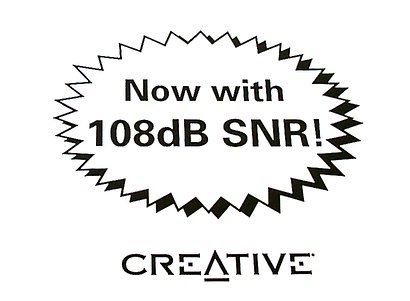  "At the very last minute of development, we were able to improve the Signal-to-Noise Ratio of the sound card from 106dB to 108dB: Please ignore any references to 106dB SNR in the installation software or manuals as these elements were finalized before our breakthrough!" Such a comment makes me doubt somehow that claimed specifications are real, especially considering the identical converters, other elements and circuitry. However, to prove it we should have re-measured these specs on at least Audio Precision System Two ($16000) that doesn't sound easy. Besides, we should have done this under the same conditions, as Creative's engineers had. But we'll get back to the measurements in general and the importance of this characteristic in particular later anyway. Now let's talk about the remote control of Audigy2 ZS Platinum Pro external block in brief. It shrank by 1.5x in height and thickness to offer more comfort and layout logic. 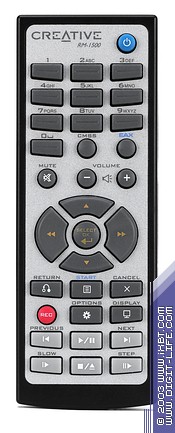 Fighting the measurement illiteracyRecently still more audio device manufacturers have been manipulating quality specs for marketing purposes. On the other hand, it's not that bad, as IT mass media alongside common users improve their knowledge and test sound parameters more often to check if they are as claimed. At the same time there's a large gap between marketing brochures and technical documents. Unfortunately for resourceful advertisers, for some reason in Russia there are evil and morose engineers instead of happy journalists. They make "malicious" measuring tests and stir up troubles by digging deep into products in general. So there's no reason to relax and sell another "long-anticipated audio revolution". SNR: there's noise, but no signalFor example, let's take Creative's favourite marketing parameter (that pesters me already) — SNR (Signal-to-Noise Ratio). With the help of abstract logic and without any electronics knowledge you might suppose it would be the difference between signal and signal noise. The higher is SNR, the higher should be sound clarity and lower should be noise. So the new 24-bit formats alongside DVD-Audio are just bound to feature higher SNR. This consumer opinion provides foundation for the entire ideology of making this parameter a motto. At www.soundblaster.com you can read: "Sound Blaster Audigy 2 ZS delivers 24-bit ADVANCED HD audio quality playback with incredible 108dB SNR." On the back of Audigy2 ZS box you can see: "Sound Blaster Audigy 2 ZS series is the only available PC platform to deliver Advanced Resolution playback at 24-bit/192 kHz in stereo or 24-bit/96kHz in 5.1 surround at 108dB SNR". Now let's turn to the well-known technical brief "Personal Computer Audio Quality Measurements" By Dr. Steven Harris & Clif Sanchez Cirrus Logic, Crystal Audio Division (458Kb) written by the Audigy2/Audigy2 ZS DAC maker: The label SNR should not be used due to industry confusion over the exact definition. As you can see, SNR is not recommended for use at all as confusing! In case of Creative, SNR stands for "Dynamic Range is the ratio of the full scale signal level to the RMS noise floor, in the presence of signal, expressed in dB FS. This specification is given as an absolute number and is sometimes referred to as Signal-to-Noise Ratio (SNR) in the presence of a signal. <...> DR can be measured using the THD+N measurement with a -60 dB FS signal. This low amplitude is small enough to minimize any large signal non-linearity, but large enough to ensure that the system under test is being exercised."
In our RMAA test we don't use SNR as well, following the recommendation above. However except for DR we also measure the Noise level by inputting minimal possible noise to the DAC that corresponds to the theoretically possible quantization noise at the given bit depth within the measured frequency range. Besides, it's often enough to disable auto-mute. Some sparse periodicals ignore RMAA for their love to everything alternative. They use pirate versions of SpectraLAB, in which SNR means THD+N expressed in dB instead of %. These enthusiasts measure SNR on a 1kHz sinusoid curve thus doing the double measurement work — harmonic distortions (hardly related to noise level (given they know meaning of those "wise terms")). And the A-weighing is naturally disabled. You can have some fun by emailing them this formula "their SNR" = 20 log ("their THD+N" / 100) — a universal conversion from % to dB.
And another thing: in measurements Creative uses the special AES17 filter that filters frequencies over 20kHz and A-weighs the result. This is entirely right for adopting the results to the average human ear sensitivity: "Example measurement result could be listed as DR = 85 dB FS A This example indicates that the dynamic range for the playback path is 85 dB relative to a Line Out full-scale value (FS). The "A" suffix indicates that an A-weighting filter was used in this measurement." However this is written in the smallest font in the specifications section, while there's "occasionally" no "A" suffix near the 108dB label. (By the way, the weighing curve isn't that simple as well. There are several variants that differ by curve intersection and zero point. This naturally provides slightly different results on different equipment and software, so it's better to conduct measurements under the same conditions.) However it's not only us that stress manufacturers — they stress us as well :) Last time, when the Audigy2 was released, their special SRC (sample rate conversion) algorithm in DSP was overloading the digital path in RMAA IMD on 19kHz and 20kHz test signal, resulting in digit array and unfeasible improbably high distortions. We've fixed it in RMAA 5.1 by replacing CCIF with SMPTE sinusoid set in the IMD test (and also found out it handles audible frequencies more adequately.) This time Creative implemented the AES17 filter to cut off frequencies over 20kHz, but didn't announce it aloud and took us by surprise a bit. Result analysis indicated that in high frequency resolutions Creative utilizes the special dithering type — noise shaping — that amassed quantization noises in the high-frequency range thus clearing the audible range. So after we examined inadequate test results (when the noise made -53dB in the 24-bit/192kHz mode without filtering!), we had to release the special RMAA version 5.2 capable of filter emulation. At that our method provides higher methodical accuracy, as only limited FFT points are considered (without analog filters side effects) at spectrum expansion and the following noise RMS calculation. The vulnerability of such "corrected" measurements is that they characterize "device-AES17 filter" chain more than the audio device itself. But there will be no such filter in real life, or rather it will be replaced by the amplifier-speaker-ear chain. Besides, there's another thing. The forced noise shaping of the card naturally negates the noise shaping recorded at DVD-Audio at mastering. By the way, we haven't measured card parameters at DVD-Audio playback. It might be so that the signal rounds or can be sent round "too smart" DSP algorithms for drawing out that useless marketing SNR out of the hardware. Another Creative's favourite is the "24-bit mode". Everyone knows that a 16-bit graphics mode is worse than 24(32)-bit. That a 16-bit CPU is loses to 32-bit. The marketing department plays upon user associations from other fields to attract him by simpler things like bit depth. However, if it's simple from the angle of graphics as human eye sees artefacts from halftone saturation, everything is more complex from the point of audio. The main reason is that the dynamic range of 16-bit sound is very close to ear's sensitivity threshold. And if you perform noise shaping and cut frequencies over 20kHz, the signal still being in the 16-bit range will subjectively sound as 18-bit. Considering there are no effective 24-bit audio DACs, it's clear why CD-DA and 16-bit audio are still in demand. However such explanation naturally can't satisfy the marketing department that needs to promote another "24-bit crystal clear sound" model. But
here enters the common opinion that digital sound is step-like! Just look how nice it is: So where can you see the real pictures? For example, in CoolEdit. Instead of those dumb "jags" (like in SoundForge, for example), it draws both samples and interpolation filter. Let's take a 10kHz sinus (the steps you see are caused only by on-screen aliasing that we left not to slow the whole process down):  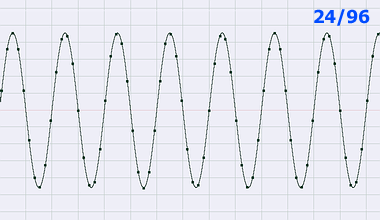 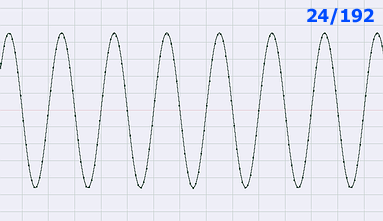 There is the difference, but it's not that impressive. Besides, it fully corresponds to acoustic sensation. Pity, but that's still evolution, not revolution. However, unlike 16/44, higher-end formats still have the potential that excites optimism. Besides, higher-resolution recordings provide better quality after compression at mixing and mastering. As least, the differences are audible even on good wooden case speaker systems like <$50 pc stereo speakers (for example, defender mercury 50). But let's get back to our cards. Is Audigy2 ZS capable of playing 24-bit sound in its real resolution?To answer this question, we must remember a way to control this. It's clear about the sampling rate, as it's seen on the gain-frequency characteristic. If the recalculation is used (like in Audigy1), this curve will drop abruptly after the half of recalc frequency is passed. We have a criterion for bit depth as well. The maximum recording dynamic range is approximately equal to 20 log (2^N), where N is the number of bits. Having measured DR and taken the inverse function, we can calculate the so-called "effective digit capacity". If it's recalculated into 16 bits somewhere, it will surely pare the final result down. DR (16-bit 44kHz within 20Hz — 20kHz) = 96.8dB = 97.8dBA DR (24-bit 96kHz within 20Hz — 48kHz) = 146.3dB = 151.0dBA As said above, there are still no DACs that use all the dynamic range. At the best the effective digit capacity is about 20 bits that stands for 120dB. Audigy2 ZS features CS4382 DAC with the following claimed specifications: 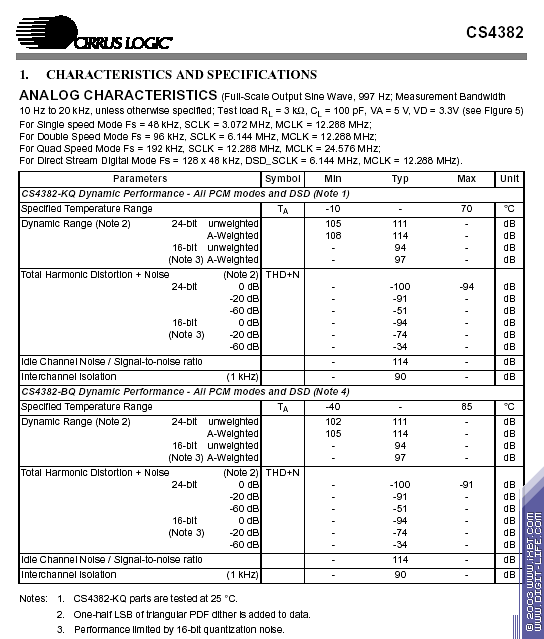 Note the comment that 16-bit DR is limited by 16-bit quantization noise. It's also indicative that 24-bit DR is 108-114 dBA. Note that these measurements were conducted within 10Hz — 20kHz at 25°C. As you know, PC chips heat up to 40-50°C that increases semiconductors' own thermal noise. By the way, SNR or "pause noise" is 114dB here, but this actually has no interest for anyone, I guess. Thus we can elaborate a criterion, so if results exceeds 16-bit theoretical limit, 24 bits are used somehow. The best card of all we tested — Lynx Two — with top-end DACs from the same maker, has 115dBA dynamic range in RMAA (APS2 shows 117dBA). 24-bit cards on Envy24HT show different results lying mostly within 100-106dBA that really seems to be true. Let's select the 48kHz mode most comfortable for the card, where there are no oversampling, and measure only the bit depth — 16 and 24 bits. We'll conduct measurements by Lynx Two with 117dBA input DR. The 20-20 filter will be disabled.
As you can see on spectrograms and in the results window, the 24-bit signal doesn't achieve parameters of 16-bit signal. Hypothetically, the reason might be some deep device mating specifics. Well! Let's do the same for card's digital S/PDIF output:
Pity, but we see the same picture. Though now we know the reason is card's digital part, i.e. DSP algorithms. This gives us hope they can be neutralized in the future drivers. To check if the program provides adequate results, we've conducted the same test on our reference card. As you can see, it works correctly within the truncation error.
Switched to the 24/96 mode, it produced the really surprising results:
This excites hope that this problem still can be solved by software. Besides, this card might have been measured with some special drivers. Anyway, this doesn't change the result. And we can't speak of full 24-bit support regarding Audigy2 ZS. Something strange resembling 16 bits is processed even through the digital path. To check if the destination card works correct, we conducted the same test on the digital output of M-Audio Revolution 7.1: Besides, the playback of the demo 24/96 DVD-Audio in WinDVD 5 (we've actually played the image from HDD to avoid DVD mechanical noise) on Audigy2 ZS and Revolution 7.1 using Event 20/20 monitors left me with a subjective feeling that Audigy2 provides fewer details. 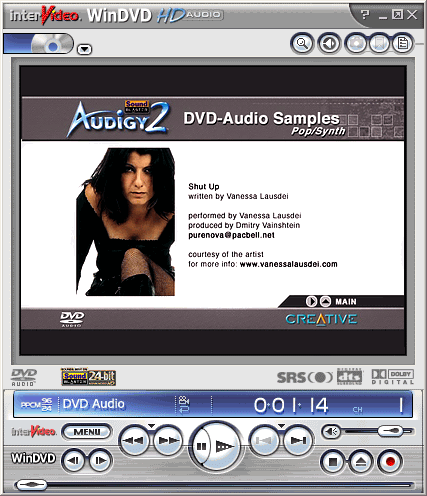 Pity, but we couldn't listen to Lynx Two, as WinDVD could only reboot the testbed with it. Bundled utilitiesIt's good news for users of previous Creative cards. According to our forum visitors, the new drivers and utilities work on almost all Creative cards, including Live. We could make this certain only on Audigy2 Platinum eX that actually worked well. Surround Mixer 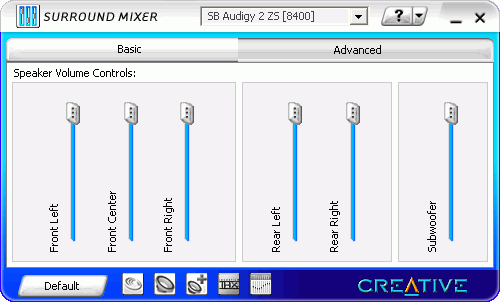 Speaker Settings   EAX Console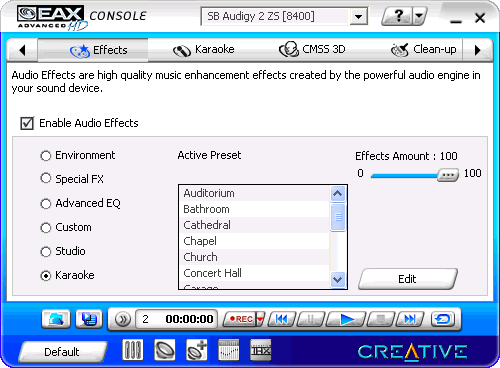  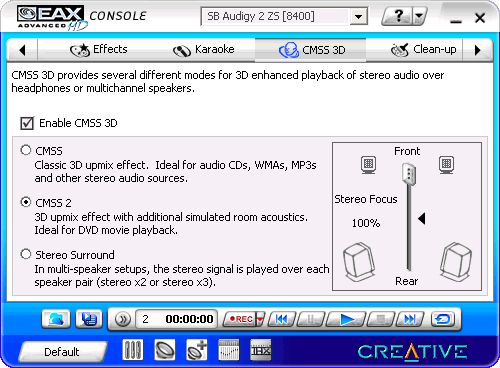 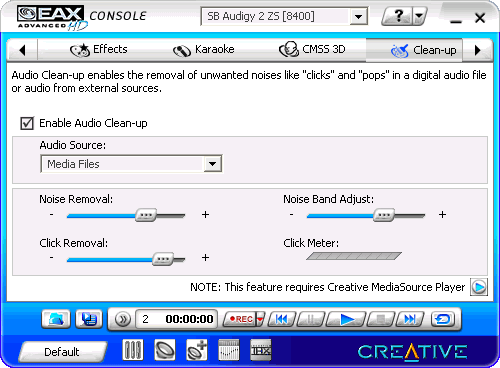 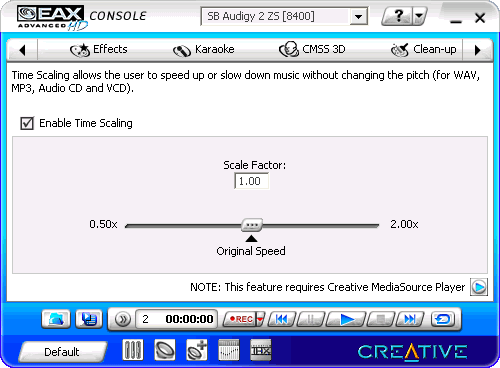 DVD-Audio player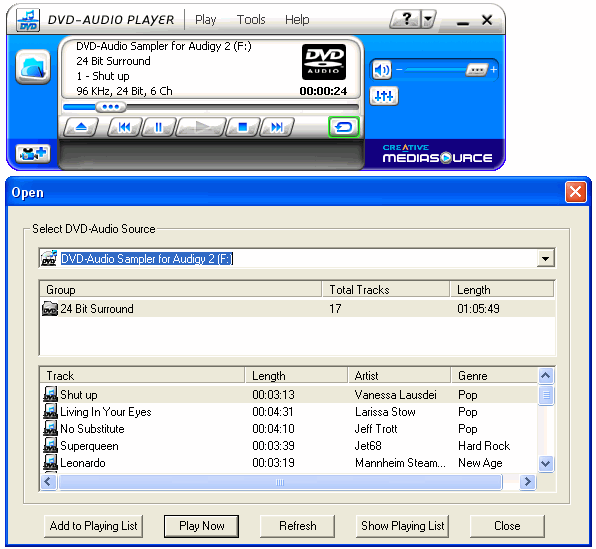 THX Setup Console 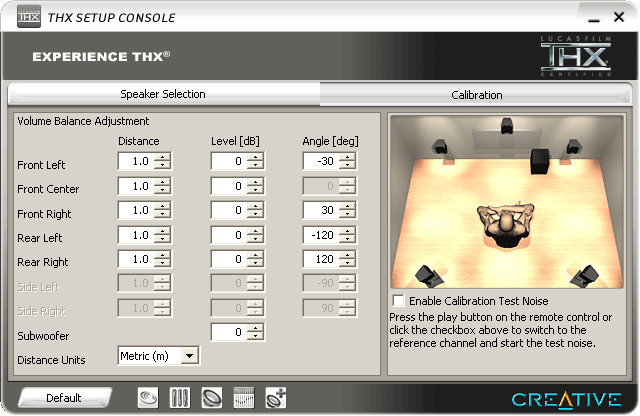 Graphics equalizer Media Player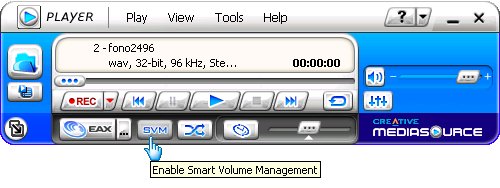 DemosAfter you install the software and reboot, you are prompted to check card's capabilities and even listen to a 24-bit/192kHz sample. Other makers don't offer such pleasures.  All card features are described in detail in special interactive presentations.   You can also compare the 16/44 stereo and 24/96 5.1 switching them on the fly. 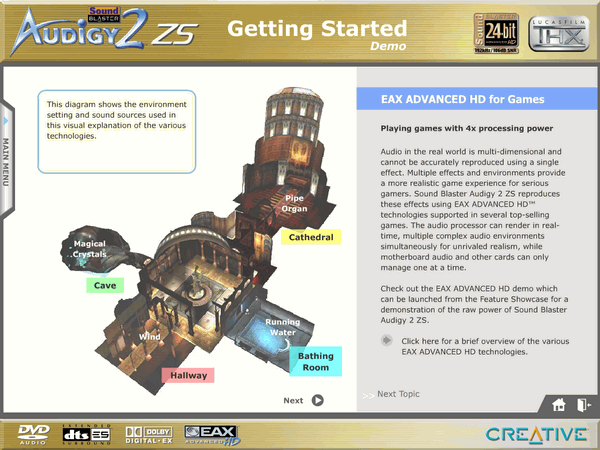 We don't even mention the nice bundled DVD-Audio. Though there's fly even in this ointment: Creative's DVD-A player can play video, so user can't see the recorded textual and graphics parts of the demo, and will have to find WinDVD 5.0 with a special DVD-Audio pack. Testing in RightMark 3DSoundWhat's interesting, the card is finally correctly enumerated in the Device manager.  Driver Version: 10.07.2003 5.12.6.402. DirectSound diagnosticsDevice: SB Audigy 2 ZS Audio [8400] (ctaud2k.sys)Features: Rates: Free buffers stats: Max buffers stats: CPU load testsTests were conducted on P4 2.53GHz with 512 DDR333. 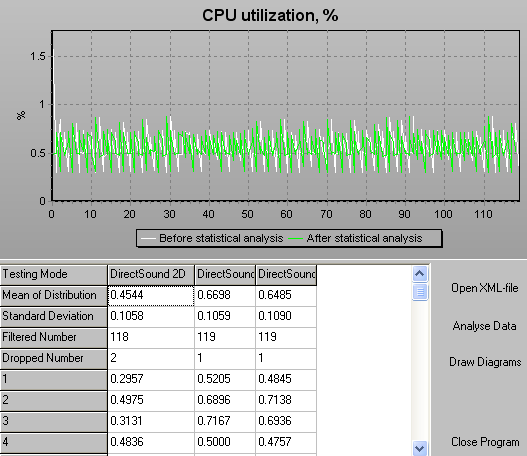
Above is the table of CPU load (%) depending on work mode and amount of DirectSound buffers. Under "/" you can see the average values and dispersion (average of distribution and mean-square deviation) for 2-minute test and accidental peaks cutoff (caused by swap, etc.). As usual Creative's solution shows excellent results of minimal CPU load even at the large number of buffers. Slightly lower load in the DS3D+EAX mode is, perhaps, caused by test order, when the data from the previous DS3D test have been partially cached in either buffer. We'll continue developing of this test to provide the most adequate results. GamesAs we found out, EAX4.0 support is expected in the next drivers release. As for the EAX4.0 games, Creative's officials can't say anything in public, but assure that there are several hits in development. For more details on EAX3.0 and EAX4.0 see the Modern Audio Technologies in Games. According to the information that we have, the EAX4.0 will be supported in Jedi Knight II with a special patch. However the existing developers' beta drivers supporting EAX 4.0 can't be correctly installed on Audigy2 ZS, but also on Audigy2. There's also no final EAX4.0 SDK available as well, only the beta. The EAX Unified 4.0 isn't included in beta SDK 4.0 (Unified drivers are required to emulate EAX4 effects on older cards like Live!). From the developer's side EAX4.0 is initialized with new IDs, but all EAX1/2/3 are also present in the SDK. The bundled TR:AoD supports EAX of some unknown version, as the game couldn't detect it without the Unified driver. Then the game recognized and enabled EAX 3.0. I must say that the EAX support isn't indicative in this game. Besides, the sound doesn't play any important role in it at all. 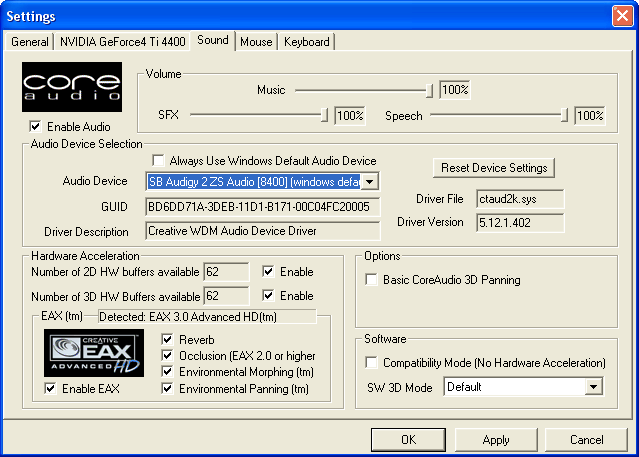 In the game with the best EAX3.0 support via OpenAL (and that's naturally UT2003), Audigy2 ZS sounded the same, as Audigy2 — excellent, outrunning all rivals by an exponent from the angle of sound clarity and 3D positioning quality. Final thoughtsThe new 7.1-channel family of Audigy2 ZS soundcards offers ideal solutions for gamers and nice choices for common users. Pity, but considering the existing drivers we can't recommend it to audiophiles before the bugfixes are implemented. For Audigy2 users there's little sense in buying this novelty. It would be much more effective to update drivers and utilities. All users of Live, Live! 5.1, and Audigy1 should upgrade only if they have higher-quality speaker systems. Pros
Contras
Write a comment below. No registration needed!
|
Platform · Video · Multimedia · Mobile · Other || About us & Privacy policy · Twitter · Facebook Copyright © Byrds Research & Publishing, Ltd., 1997–2011. All rights reserved. |